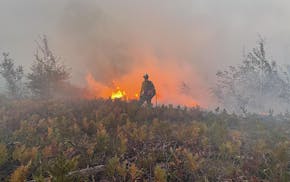It's Superb Owl weekend. Who are you rooting for?
Who? Who?
The great horned owls? The little saw-whets, barely a handful of owl? Screech owls? Barred owls with their fathomless dark eyes? The Raptor Center has seen them all and helped them all.
Maybe you're more a fan of the Eagles or the Falcons. You can cheer them at the University of Minnesota's Raptor Center, too.
But the comeback story of 2024 is unfolding on the shores of icy Gervais Lake in Little Canada. Meet the chimney owl.
On Friday, as snow flurries swirled, a group of rescuers gathered around a small white crate. Three … two ... one. … Andrew Kramarczuk slid open the lid, revealing a fluffy, confused owl that had taken a tumble down the family's chimney.
It was mid-January when the Kramarczuks heard the first scrape of claws on the other side of the chimney damper.
"It sounded like a squirrel or something," said his father, chef Orest Kramarczuk, who watched the release on his phone from Florida. "But one morning, I was sitting with my dog and I hear a 'hoot hoot.'"
The Kramarczuks — of Kramarczuk's deli fame in Minneapolis — called the Raptor Center. Such calls for help pour into the center every day. Kestrels hit by cars. Bald eagles poisoned by lead shot. Owls snared in soccer nets. Fledglings tumbled from nests.
For a moment, the barred owl sat there. Looking up at the sky, looking up at its rescuer, thinking things over. Then off he flew, flapping noiselessly back to whatever spring plans he'd been making before he confused the Kramarczuks' chimney with a hollow tree.
The Raptor Center rescues a thousand or more birds a year. Each one they save is a celebration.
The Gervais Lake owl arrived scraped, bruised, dehydrated and covered in soot. This is chimney owl season — when barred owls go searching for nice nesting nooks and sometimes end up tumbling down chimneys instead.
"The chimneys are too narrow for them to fly out. They can't climb either, although they do really try," said Lori Arent, assistant director of the Raptor Center at the U's College of Veterinary Medicine in St. Paul. "It's really, really sad."
Along with top veterinary care, the rescued birds enjoy the avian equivalent of a luxury spa. Their talons are sharpened. If they have broken or missing feathers, Raptor Center staffers will glue on replacements so they can fly. If they've lost muscle tone during their recovery, they go on test flights to make sure they are fast and agile enough to return to the wild.
The soot-covered chimney owls even get a bath.
"It's a process, to give an owl a bath," Arent said with a laugh. But the soot in their feathers can make them sick if they inhale while they're preening their feathers. So into the suds they go. Sometimes more than once.
Every bird is fitted with an identification band before release. Which is how the Raptor Center recognizes repeat visitors — like an owl that the center saved a few years ago, then saved again three months later when it fell down another chimney.
Look, they can't all be wise owls. Here's hoping the next chimney that owl explores is protected with a chimney cap.
The Raptor Center's work is supported by a small army of volunteers and by community donations. There are probably some out there who wonder why they bother.
Most of the raptors brought to the center, Arent said, were harmed by contact with humans. Humans who set out poisoned bait. Humans who tossed trash out the car window, luring rodents to the road side, which in turn lured raptors into traffic. Humans who fill their airspace with power lines. Humans with good intentions, who scoop up fuzzy owlets after they tumble off a branch and accidentally cause them to imprint and lose the fear of people they need to survive.
Helping the birds we put in harm's way is the kind and compassionate thing to do. But Arent and her team have also found that helping the raptors helps us.
"We've learned that they are sentinels into what's happening in our environment," she said. "Every patient that comes in is like a data point. They give us so much information about what's going on in our environment. When West Nile [virus] first came into our environment, we saw it first in great horned owls we admitted, before anyone knew it was here."
To watch the superb owls in person, you can schedule a tour of the Raptor Center or sign up as a volunteer at raptor.umn.edu. What else would you be watching?

Brooks: Only you can prevent wildfires, Minnesota
Brooks: Minnesota state senator's burglary arrest puts private family drama in the election year spotlight
An Isanti wedding venue closed without warning. Now these couples have 'nowhere to go.'

Brooks: A tale of 124 hoarded Minnesota cats has at least a hundred happy endings

